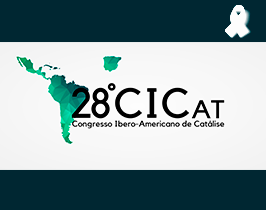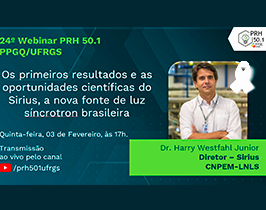Accessibility Tools
 A Universidade de Sevilha abre vaga para ingressar no Doutorado e Pós-Doutorado, no projeto Nicer Biofuels.
A Universidade de Sevilha abre vaga para ingressar no Doutorado e Pós-Doutorado, no projeto Nicer Biofuels.
A oportunidade é para candidatos que se graduaram em Química, Engenharia Química ou áreas correlatas.
Clique AQUI para mais informações.
 28ºCICAT: XXVII Congresso Iberoamericano de Catálise: Catálise e Conhecimento sem Fronteiras
28ºCICAT: XXVII Congresso Iberoamericano de Catálise: Catálise e Conhecimento sem Fronteiras
O 28º CICAT acontecerá nos dias 18 a 23 de setembro de 2022 e terá início com a Escola de Catálise, entre os dias 01 a 05 de agosto. O tema do evento nessa edição é "Catálise e Conhecimentos sem Fronteiras ", motivado pela distância imposta pela pandemia e eventos virtuais. O objetivo é a troca de experiência, estreitamento de contatos e colaboração entre pesquisadores, profissionais e alunos. O Congresso terá conferências plenárias e keynotes proferidas por pesquisadores de renome nacional e internacional, além das sessões técnicas. Haverá, ainda, a cerimônia de entrega dos Prêmios Pesquisador Sênior e Pesquisador Junior da FISIOCAT, além de uma conferencia de abertura especial comemorativa dos 25 anos da Sociedade Brasileira de Catálise. O evento será organizado pela diretoria da SBCat em conjunto com a Universidade Federal do Rio Grande do Norte - UFRN e acontecerá de forma totalmente virtual.
 O Sócio da SBCat, Jean Marcel Ribeiro Gallo, docente do Departamento de Química da UFSCar foi indicado como 2021 Class of Influential Researchers (Classe de Pesquisador Influente), pela Industrial & Engineering Chemistry Research, da American Chemical Society (ACS).
O Sócio da SBCat, Jean Marcel Ribeiro Gallo, docente do Departamento de Química da UFSCar foi indicado como 2021 Class of Influential Researchers (Classe de Pesquisador Influente), pela Industrial & Engineering Chemistry Research, da American Chemical Society (ACS).
O prêmio indica os pesquisadores mais influentes na área de Química Industrial e Engenharia Química com até 10 anos de carreira independente, ou seja, a partir de quando começou a ser líder de um grupo de pesquisa. No caso da academia, conta-se a partir do momento em que se tornou professor.
Em 2021, essa honraria foi dada a 36 pesquisadores que se destacaram na área. São todos de universidades norte-americanas e canadenses. O Jean Marcel Gallo foi o único de universidade latino-americana na lista de premiados.
O prêmio consiste em uma placa e na veiculação de um artigo do pesquisador em uma publicação especial que reúne todos os vencedores.
Clique AQUI para mais informações sobre o prêmio.
 A Profa. Heloise O. Pastore (IQ/UNICAMP), sócia da SBCat e membro do CA/Quimica/CNPq, assumiu, desde o primeiro dia de 2022, o importante cargo de Editor-in-Chief do prestigioso periódico Microporous and Mesoporous Materials (Elsevier), a revista oficial da International Zeolite Association (IZA). A revista possui atualmente fator de impacto 5,45 (cite score de 8,3 em 2021), ocupando a 12ª posição entre 74 das mais importantes da Elsevier, na área de Química (para mais detalhes, clique AQUI).
A Profa. Heloise O. Pastore (IQ/UNICAMP), sócia da SBCat e membro do CA/Quimica/CNPq, assumiu, desde o primeiro dia de 2022, o importante cargo de Editor-in-Chief do prestigioso periódico Microporous and Mesoporous Materials (Elsevier), a revista oficial da International Zeolite Association (IZA). A revista possui atualmente fator de impacto 5,45 (cite score de 8,3 em 2021), ocupando a 12ª posição entre 74 das mais importantes da Elsevier, na área de Química (para mais detalhes, clique AQUI).
A Profa. Heloise é a primeira mulher e cientista latino-americana a ocupar tal cargo e, assim, entra para o seleto grupo de cientistas que ocupam o cargo de Editor-in-Chief em revistas renomadas. A Regional 3 e a SBCat parabenizam a Profa. Heloise pela merecida indicação, que vem laurear sua trajetória de grande dedicação à química de materiais e à catálise. Vale lembrar que a Prof. Heloise recebei em 2021 o Prêmio Mulheres na Catálise da SBCat.
 Título: “Os primeiros resultados e as oportunidades científicas do Sirius, a nova fonte de luz síncrotron brasileira"
Título: “Os primeiros resultados e as oportunidades científicas do Sirius, a nova fonte de luz síncrotron brasileira"
Palestrante: Dr. Harry Westfahl Junior - Diretor do Síncrotron brasileiro Sirius - CNPEM.
Data: 03/02/2022
Horário: 17:00hrs
Local: Transmissão online
ConfiraAQUI o link para a transmissão.
Contamos com a presença de todos!
Mais informações sobre o PRH50.1 PPGQ/UFRGS: Site | LinkedIn
